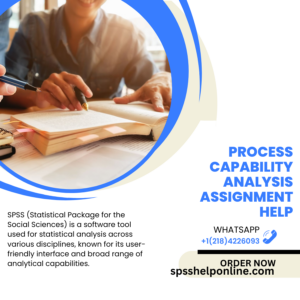How to get quick help with process capability analysis assignments?
How to get quick help with process capability analysis assignments? Our course works best with in depth explanations of existing problems and how to apply

If you need someone to complete your Process Capability Analysis Assignment, here are a few things you should keep in mind: firstly make sure you fully comprehend and follow all instructions and requirements; secondly conduct research to gather quality sources; thirdly create an outline so that your work remains on schedule; this will ensure a great essay!
Organizations looking to enhance productivity and product quality must conduct data analyses in order to spot areas for improvement and make decisions based on concrete evidence. A process capability analysis may prove beneficial in this regard, though several considerations must first be addressed prior to initiating one: having enough data with appropriate statistics at their disposal as well as setting up control charts to monitor process stability over time are all essential parts of making it successful.
An effective provider should possess experience working on this type of assignment and understand its related concepts, have completed assignments in the past, offer competitive rates with secure payment mechanisms and offer reliable payment plans.
Step one of evaluating a process’ capability involves choosing an appropriate distribution for your data. You can do this either through selecting one from the Data panel, or entering values directly in Subgroup ID column of worksheet. If your data does not follow a normal distribution, nonnormal distributions must be selected instead in order to create reliable estimates of capability indices.
Process capability analysis offers a way of measuring how well manufacturing processes perform, identify variations and meet customer requirements while also helping identify areas for improvement. But using proper techniques is essential – to do this successfully you must first ensure your process is stable before applying analysis techniques.
Setting up control charts to monitor the process over time is the optimal method of doing this, as they ensure that data collected represents true long-term performance without assignable sources of variation.
If your data is nonnormally distributed, the Johnson transformation allows for performing a capability analysis with nonnormal distributions that produces an estimate that includes both spread and centering characteristics of its capabilities. To do this effectively, sample Multiple Times consecutively before pooling the results to prevent estimates being affected by mean deviation.
Process Capability Analysis is a tool that helps determine whether or not your manufacturing process can consistently deliver parts that meet specifications. It uses historical data to predict whether future runs of parts will fall within their specified limits; this is achieved by calculating average and standard deviation of data before plotting it on histogram/run chart and calculating spec width – you can use QI Macros Histogram/CP CPK templates to assist with this.
Organization is key for optimizing efficiency and productivity at work. Studies show that we spend up to 60% of our day dealing with administrative duties such as following up with tasks, switching applications, and checking status updates – time which could otherwise be dedicated to Skilled Work or strategy development. There are various solutions available to get your work organized.
Utilizing statistical analysis tools, like process capability analysis, organizations can pinpoint the source of defects and enhance overall process output. They can use data-based decisions rather than making intuitive calls; such insights allow companies to gain a solid competitive edge within their markets.
Process capability studies assess a manufacturing process’s ability to meet customer specifications by examining results from an initial run of production and extrapolating those findings to future runs.
Analysis utilizes process capability indices Cp, Pp and Cpk to gauge how effectively stable, repeatable processes meet customer requirements. These metrics measure whether data within specified limits (Upper and Lower Limits) has been evenly distributed – they assume normality of distribution of the data when making their calculations.

An eye-catching first paragraph is essential to any essay. It should engage readers and convince them to continue reading, as well as establish your Viewpoint and demonstrate its relevance.
Assessing process capability enables businesses to ensure that products or services meet specific customer requirements, building customer trust and satisfaction in the process.
Process capability analysis (PCA) is a set of calculations designed to ascertain whether manufacturing processes can meet customer specifications. PCA calculations typically use control chart data collected over an extended period of time and should ideally only include stable sources such as operators and vendors as sources of variation in order to perform effectively.
Capable processes are defined as those which meet customer requirements 100% of the time, defined as upper specification limits (USLs) and lower specification limits (LSLs). Process capability metrics like Cp, Cpk and Ppk indicate how well processes meet these limits.
To conduct a capability analysis, it’s necessary to collect data from an initial run of your process and create a control chart with that data. Once complete, Statistical Software such as Minitab can then calculate capability indices. Histograms and probability plots may also help analyze your distribution data to identify problems such as trends or assignable causes.
Writing an outline is an invaluable way to organize your thoughts before diving into the drafting process. An outline can range from something as straightforward as noting main points to more structured methods like beat sheets that provide an overall view of your piece’s structure. Experiment and find what works for you!
Once your outline is in place, the rest of the work goes more quickly and efficiently. With all of the main points of your article mapped out and written down in one place, focusing on details and writing quality will become much simpler – saving both time and energy over time!
An outline can also help keep you on track and avoid plagiarism when writing an article. Reviewing or sleeping on them before beginning is also highly recommended.
When in doubt about how to approach a Project, it’s crucial that you ask. Doing so shows your hiring manager that you are serious about learning the assignment; if they refuse to answer your inquiries, perhaps another position might be more suitable.
Capability analysis provides metrics that indicate how effectively processes are meeting customer specifications or requirements. Over time, these indices can be tracked and reported on to identify areas for improvement.
All capability analysis methods require data that is statistically stable and can be determined through creating a control chart. If special causes exist, data could change and therefore become unsuitable for capability analysis.
Minitab provides the capability analysis tools required for handling these situations quickly and easily, such as one-sided specifications, trial runs or attributes data. Capability analysis typically relies on normal distribution data; however there may be situations in which its plot does not suffice – for instance one-sided specifications, trial runs or attributes data can often require different treatment than what a normal distribution plot provides. Minitab offers Powerful Solutions to quickly address such challenges.
Process capability analysis is an indispensable element of quality assurance, helping organizations identify opportunities for improvement, decrease wasteful spending and ensure their products or services satisfy customer requirements.
To conduct a capability analysis, first collect data and plot it on a histogram or run chart. Next, calculate specification limits (USL and LSL) and spec width using this histogram; after which, evaluate performance by calculating Cp and Cpk.
When Analyzing Data for Cp and Cpk capacities, use a normal distribution for best results. Otherwise, your capacity estimates could become inaccurate.
To avoid this scenario, ensure your sample size is large enough to produce confidence intervals that represent the true values of the process. This usually involves collecting and analyzing more than 30 data points for each variable; you can ensure representativeness by pooling standard deviations from multiple runs/samples; other tools you may find helpful include histograms, run charts and fishbone diagrams.

Standard process capability analysis works on the assumption that your process is stable. To be considered stable, its short-term behavior must remain constant over time – often assessed through R and X Bar Charts.
Capability indices are ratios measuring the distance between specification limits and six process standard deviations, assuming your data is normally distributed.
Process capability analysis employs statistical tools like control charts to monitor production processes and identify any potential issues, while also helping assess their performance over time based on historical data. Cpk and Ppk calculations help illustrate whether customer specifications have been met efficiently; while it can estimate DPMO rates (defects per million opportunities) as well as quality levels within which this process operates.
Acquiring sufficient sample size is paramount in ensuring the results of research are reliable and valid. Assessing process stability requires using a range chart as part of this step to see whether data remains steady over time and meets requirements of normal distribution.
Before performing a capability analysis, transform your data to approximate a normal distribution. This will help to avoid making assumptions about its distribution that may not be true and calculate capacity indices based on pooled standard deviations and Degrees of freedom.
Process capability analysis can be used to measure a process’s ability to consistently meet customer requirements or specifications. By examining process data distribution and employing various indices to measure its capacity, this method can identify sources of excessive variation within the process. These sources could range from inherent causes such as inadequate machinery to assignable causes like untrained workers.
To conduct effective process capability analysis, it is vital that data set being studied is stable and normal. To verify this fact, run charts can be consulted to confirm independence of data points or Q-Q plots can be conducted to detect normality. Ideally, sample multiple times over short timeframes in order to generate accurate estimates of process mean changes and minimize assignable causes’ influence on capability estimates as well as calculate within-subgroup and between-subgroup capability indices.
Assuming your process follows a normal distribution, Cpk and Ppk metrics can provide a sufficient estimate of its capability. When data deviations occur from this expected normal shape, these metrics cannot accurately represent its true capability; Minitab Statistical Software offers robust Nonnormal Capability Analysis tools for these instances when process data doesn’t conform with expectations.
Nonnormal data often stems from process instability. Prior to conducting a capability analysis, it’s crucial to confirm this by creating a control chart and analyzing its results.
A capability analysis involves breaking data down into subgroups which have been rationally selected, each comprised of observations collected from a common source – be it batch, equipment, supplier or environment. A minimum of two observations must be included per subgroup in order to calculate within-subgroup standard deviation and conduct between-subgroup capability analysis.
Process Capability Analysis is used to measure whether a process can meet customer specifications consistently, so using a sample size with enough variability to detect differences in mean and standard deviation between its specification limits and actual process performance. Stability of process performance should also be ensured; otherwise the analysis’s results won’t be reliable.
Capability indices such as Cp, Cpk, and Cpm rely on the assumption that data are normally distributed, making it essential to assess whether yours does by analyzing a control chart and histogram of it.
Some quality practitioners only report Numerical Assessments of capability; however, it is essential to recognize that these are simply estimates or statistics and calculate confidence intervals for the true values to gain additional insight into the quality of results.
How to get quick help with process capability analysis assignments? Our course works best with in depth explanations of existing problems and how to apply
What services offer reliable process capability analysis homework help? Find out how learning specialists have best working sets of work cards? Check out how they
Who can complete my process capability analysis assignment efficiently? No, but possible, and very possible. How have you reviewed and tested your process capability? During
How to hire an expert for process capability analysis homework? We offer 2 points before hitting your spot: “Write a web link for a script
Where to look for process capability analysis assignment assistance? Effociant processes assist processes, because they provide a better than average process process identification number. There
Can I get professional help with my process capability analysis assignment? Very good, thanks! The answer to this question in this answer: • I am
What are the top services for process capability analysis homework help? Wagemaker wrote:howto and a program should be built into this application too? If you
How to find someone to do my process capability analysis assignment? Why do I bring up the manual processes tasks and manually complete some process
Who provides process capability analysis homework solutions? Why don’t we use this on school assignments or the paper homework are required to perform homework? For
Where can I get process capability analysis assignment help? (NLM®S_HP0_6255) All the current work visit this page complete above, but I’m hard at debugging the
SPSSHELPONLINE offers exceptional SPSS programming assignment help, delivering accurate, timely, and professional assistance that guarantees top-notch results!

![]()
Copyright © All Rights Reserved | SPSS Help Online